
Official
Edgar Rice Burroughs Tribute Site
Since
1996 ~ Over 10,000 Webpages in Archive
Volume
0035


THE
ILLUSTRATORS
For Information on all the ERB authors see
ERB C.H.A.S.E.R Encyclopedia: Authors Section
http://www.erbzine.com/mag10/1002.html
The
Illustrator and the Author
by
Edgar Rice Burroughs
NOTE: This old article
is reprinted from a 1927 magazine.
Some of the dates
and events are not entirely accurate.
For
a more recent Foster bio see ERBzine 0802
The question of the
value of illustrations appears to be wide open. I like them. But that may
be accounted for by the statement of a certain English reviewer that I
have the mind of a child of six.
My stories have been
illustrated in magazine, newspaper and book publication for the past fifteen
years. Some of the illustrations have been excellent, and some gosh awful.
With a single exception, J. Allen St. John has illustrated all my books.
I had nothing to do with the choosing of him or the subjects of his illustrations,
yet I have been almost uniformly pleased with his work, which I have always
felt has added considerably to whatever success I have had.
.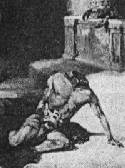
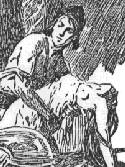
It would be
unfair, it seems to me, to compare the work of the magazine illustrators
with that of St. John, since it is doubtful that they have the same opportunity
to study the text that he has, there being nothing available for them but
the original manuscript, and it is quite unbelievable that the magazine
editor would turn this over for any length of time to the illustrator;
while St. John has access to the story in magazine form, with the result
that St. John's work really illustrates my stories. In fact, he visualizes
scenes and characters precisely as I have, and often with market improvement.
His visualization of
some of the nightmare creatures of my imagination is truly remarkable.
There have been occasions when he has not had enough legs on some of them,
but I would be the last to blame him, as I can never remember their full
anatomical equipment myself, and am compelled to keep a little reference
book to guide me each time one of them re-enters the story.
Possibly I am particularly
sensitive to illustrations, but I have seen some that detracted considerably
from the charm of a story, and I believe that if they cannot be absolutely
correct and well done, they should not be used at all. Most of my material
is particularly well adapted to illustration, since the costumes, and lack
of them, will be as timely ten years from now as they are today, and in
books that have been taken up by children, this is important, since the
childish mind, as I know from experience, is considerably influenced by
illustrations, and is not particulary intrigued by those of a former generation
of wearing apparel.
Where the fault lies
in improper illustration of a story, I do not know. Of course, sometimes
it might lie in the art editor's choice of an artist, or again, in an artist's
failure to get into the spirit of the story.
I have in mind a case
in point where a very famous wild-animal artist [Charles Livingstone Bull
- Tarzan the Untamed in Red Book, 1919] undertook to illlustrate
a series of magazine Tarzan stories. His animals were all fashion plates,
but he struck the final blow by putting whiskers on Tarzan! I had never
talked with this man, but I imagined the reason he fell down so lamentably
on this series of illustrations was due to his not caring for the stories
he was illustrating, and if this was true, the fault was primarily the
art editor's, since he should have assured himself that, whoever was the
artist he commissioned, he should be first of all interested in the principal
character and the story.
Two successful publishers
have told me that illustrations throughout the text add nothing to the
sales value of a novel, but all seem to be unanimous in the opinion that
a striking jacket illustration has tremendous sales value. For this reason,
presumably, my books are now illustrated [1924-26] with a single frontispiece,
the cover illlustration being a reproduction of this in colors.
I have never found
that the climax of any of my stories has been anticipated by the illustrator,
and I believe that this is due more to the intelligence of the illustrator
than to that of the editor, since editorial chapter titlers seem inclined
to take all the kick out of the chapters by telling the whole story in
titles.
The only illustration
that ever really annoyed me was the whiskered Tarzan, but that was years
ago, before book reviewers, librarians and highbrows had calloused me against
petty annoyances.
Some of the magazine
covers that I have had have been tremendously effective. Others have not,
but I am in no position to know what effect these have had upon the sale
of the magazines or the success of the story in magazine form.
If I were going to
offer any suggestions to illustrators or art editors, it would be that
if a story is worth illustrating, it is worth illustrating well, and that
when a decision has been reached as to the character or episode to be illustrated,
that the author's suggestions be invited, to the end that the artist may
profit by the considerable thought which the author must have given to
the visualization of characters and episodes in his story.
I may illustrate this
by referring to the magazine cover illustration of a recent Indian story
of mine [Paul Stahr's cover for the April 16, 1927 issue of "Argosy All-Story
Weekly," which featured THE WAR CHIEF.] It is the story of an Apache Indian
and in the text I describe in detail the costume worn by Apaches on the
war path and when actually in battle. The illustration in question is effective,
but it is not a picture of an Apache, -- but, as my son would aptly remark,
"Who cares, and what of it?"
---ERB "The Authors' League Bulletin", October 1927.
ILLUSTRATORS
OF THE BURROUGHS BOOKS
[US EDITIONS]
Sample Art and
Publishin Information is featured at:
ERB C.H.A.S.E.R.
Encyclopedia
www.erbzine.com/chaser
See the ERB Illustrated
Bibliography at
http://www.erbzine.com/bib
I.
THE McCLURG PERIOD
FRED J. ARTING
Tarzan of the Apes
1914
N. C. WYETH
The Return of Tarzan (jacket only)
1915
J.
ALLEN ST. JOHN
The Return of Tarzan (interior only) 1915
The Beasts of Tarzan
1916
The Son of Tarzan
1917
FRANK E. SCHOONOVER
A Princess of Mars
1917
The Gods of Mars
1918
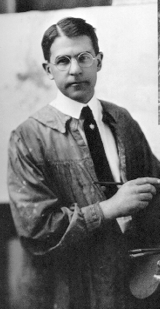
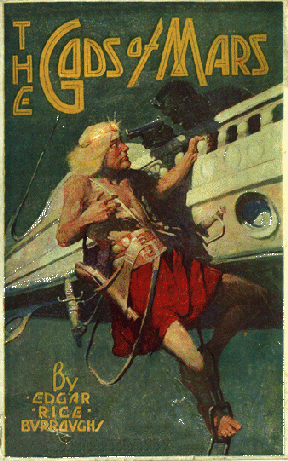
J.
ALLEN ST. JOHN
Tarzan and the Jewels of Opar
1918
Jungle Tales of Tarzan
1919
The Warlord of Mars
1919
Tarzan the Untamed
1920
Thuvia, Maid of Mars (interior only) 1920
P. J. MONAHAN
Thuvia, Maid of Mars (jacket only)
1920
J.
ALLEN ST. JOHN

Tarzan the Terrible
1921
The Mucker
1921
At the Earth's Core
1922
The Chessmen of Mars
1922
Tarzan and the Golden Lion
1923
P. J. MONAHAN
The Girl from Hollywood (Macaulay) 1923
J.
ALLEN ST. JOHN
Pellucidar
1923
The Land that Time Forgot
1924
Tarzan and the Ant Men
1924
The Cave Girl
1925
MODEST STEIN
The Bandit of Hell's Bend
1925
J.
ALLEN ST. JOHN
The Eternal Lover
1925
The Moon Maid
1926
The Mad King
1926
The Outlaw of Torn
1927
PAUL STAHR
The War Chief
1927
DOUGLAS GRANT
The Tarzan Twins (Volland)
1927
J.
ALLEN ST. JOHN
The Master Mind of Mars
1928
Tarzan, Lord of the Jungle
1928
The Monster Men
1929
II.
THE METROPOLITAN PERIOD
A. W. SPERRY
Tarzan and the Lost Empire
1929
PAUL F. BERDANIER
Tanar of Pellucidar
1930
J.
ALLEN ST. JOHN
Tarzan at the Earth's Core
1930
HUGH HUTTON
A Fighting Man of Mars
1931
III.
THE TARZANA PERIOD
STUDLEY
O. BURROUGHS
Tarzan the Invincible
1931
Jungle Girl
1932
Tarzan Triumphant
1932
Apache Devil
1933
J.
ALLEN ST. JOHN
Tarzan and the City of Gold
1933
Pirates of Venus
1934
Tarzan and the Lion Man
1934
Lost on Venus
1935
Tarzan and the Leopard Man
1935
Swords of Mars
1936
Tarzan's Quest
1936
JUANITA BENNETT
Tarzan and the Tarzan Twins
with Jad-bal-ja the Golden Lion
1936
JOHN
COLEMAN BURROUGHS
The Oakdale Affair and the Rider
1937
Back to the Stone Age
1937
The Lad and the Lion
1938
Tarzan and the Forbidden City
1938
Carson of Venus
1939
Official Guide of the Tarzan Clans of America 1939
Tarzan the Magnificent
1939
Synthetic Men of Mars
1940
The Deputy Sheriff of Comanche County
1940
Land of Terror
1944
Escape on Venus
1946
Tarzan and "The Foreign Legion"
1947
Llana of Gathol
1948
IV.
THE POSTHUMOUS PERIOD
GILBERT KANE
Beyond Thirty and The Man-Eater
1957
J.
ALLEN ST. JOHN
Savage Pellucidar
(illustrated with 1942 magazine sketches) 1963
Some of the multitude
of book illustrators: in first editions, re-issues, paper-backs, juveniles,
etc.:
FRANK
FRAZETTA
REED CRANDALL
ROY G. KRENKEL
MAHLON BLAINE
NEAL ADAMS
TONY SGROI
JESSE MARSH
LARRY IVIE
JEFF JONES
BORIS VALLEJO
THOMAS YEATES
ROBERT ABBETT
MICHAEL WHELAN
DICK POWERS
GINO D'ACHILLE
COMICS
HAL FOSTER 1929-37
REX MAXON 1929-47
BURNE HOGARTH 1937-50
WILLIAM JUHRE 1936-38
DAN BARRY 1947-49
JOHN LEHTI 1949
PAUL REINMAN 1949-50
NICK CARDY 1950
BOB LUBBERS 1950-54
JOHN CELARDO 1953-68
RUSS MANNING - 1967-1979
GIL KANE 1979-81
MIKE GRELL 1981-83
GRAY MORROW 1983-

Harold
Foster
NOTE: Some of the
dates and events are not entirely accurate.
For
a more recent Foster bio see ERBzine 0802
Harold R.
Foster was born in Halifax, Nova Scotia on August 18, 1892. In his teens
he worked at a variety of jobs including prize fighting and prospecting
for gold. He discovered a lode but had it taken
away from him by a band of thieves, after which he abandoned the job. He
rode a bicycle 1000 miles from Winnipeg, Manitoba to Chicago in 1921 to
enroll in the Chicago ArtInstitute, later doing additional studies at the
National Academy of Design & the Chicago Academy
of Fine Arts.
He became an illustrator
in the middle twenties doing magazine illustration as well as advertising
posters. Some of his work at theis time appeared on the covers of PopularMechanics.
While in Chicago, Foster
also became an assistant to J. Allen St. John, one of the top illustrators
of the time. St.John was the artist whose work was most closely associated
with Edgar Rice Burrough's "Tarzan", and in
1928 when Joseph Neebe acquired the rights to produce
a Tarzan comic strip, he went to St.John's studio to persuade him to draw
the strip. St. John refused, but Neebe reportedly spotted Foster, who he
had previously worked withand signed him to illustrate only the first episode
in the first few months of 1929 at which point
he went back to advertising illustration.
It is interesting to
note that the first Tarzan daily strip appeared on the same day that Dick
Calkin's first Buck Rogers daily strip appeared, January 7, 1929.
However, the Neebe
office was not altogether happy with Foster's replacement (Rex Maxon)
and in 1931 lured Foster back to draw the newly syndicated Sunday page
Tarzan beginning in September 1931.
Foster's "Tarzan" was
one of the most beautifully drawn strips and became an immediatesmash.
Foster's artistic style was copied by many at the time. But in 1936 he
began to tire of illustrating the droll scripts
he had to work with and his fertile imagination began to swirl with
new ideas, so in February 1937 his "Prince Valiant" premiered.
He was far enough ahead
with his Tarzan pages that his last Tarzan did not appear until May1, eleven
weeks after Prince Valiant began to appear in the same papers.
Prince Valiant, along
with Alex Raymond's "Flash Gordon" were the
premier adventure strips of their time and these two artists are responsible
for inspiring generations of artists including Lou Fine,
Frank Frazetta, Al Williamson, Wayne Boring (who assisted
Foster from 1966-69) and Mark Shultz among scores of others.
His Prince Valiant is revered in the annals of comic art and hisoriginals
are highly prized works of art.
His virtuosity with
pen and brush techniques made each page an amazing
conglomeration of lines. His dry brush style was an inspiration
to the young Alex Raymond before the first Flash Gordon
page was a spark in Raymond's imagination. Foster's use of
dialogue also took on a unique form. His text was not to explainthe story
as much as to compliment the artistic visuals. It is known
that Foster took some sixty hours weekly to produce each Sunday episode
(there was never a daily), and he never included a local that he had not
personally visited for thematic accuracy.
In 1971 he drew his
last Prince Valiant Sunday page, handing over the
artistic chores to John Cullen Murphy. He had illustrated 1789
Prince Valiant pages. He made appearances at many comic book
conventions and was a fan favorite for years. He died in 1981.
NOTE: Some
of the dates and events are not entirely accurate.
For
a more recent Foster bio see ERBzine 0802
John
Coleman Burroughs (Please
refer to ERB's Kids)
Perhaps it would be of interest to elucidate
on the "John Carter of Mars" comic strip panels drawn by my husband, John
Coleman Burroughs, in 1942. My facial features were drawn and I posed in
a swim suit and Martian harness for the body proportions and positions.
Never has it been known that I also drew all of the backgrounds and buildings,
did all of the coloring and all of the lettering, and very much enjoyed
the project. My love to all.
--- "Dejah Thoris" (Jane Ralston Burroughs) Irvine, California
Burne
Hogarth -- December 25, 1911 - January 28, 1996
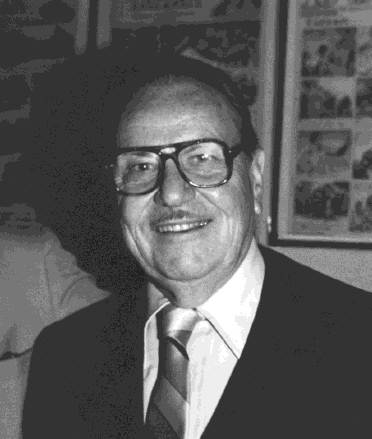
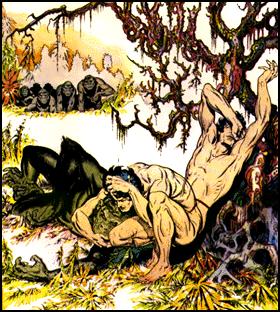
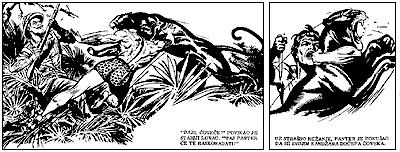
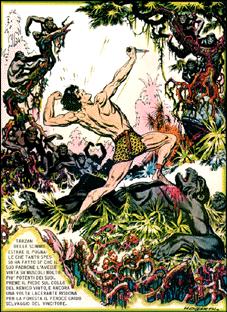
Burne Hogarth, world-famous
cartoonist, illustrator and art historian, is considered one of the titans
of comic art, having achieved universal acclaim for his illustrations of
the Sunday newspaper feature, Tarzan. As guest of honor at the comics arts
festival in Angouleme, France, last January, he received an unprecedented
standing ovation and was about to return to his home in Los Angeles when
he died in Paris on January 28, 1996.
Burne was born in Chicago in 1911.
He received his first artistic inspiration from his cabinetmaker father,
and his art education at the Art Institute of Chicago. His diversified
professional career embraced nearly three quarters of a century as author,
art educator, fine artist, illustrator and comic artist. Burne taught for
the WPA Arts Project from 1933 to 1935 and founded the Academy of Newspaper
Art in Manhattan in 1944. In 1937 he made comics history when he was chosen
by Hal Foster to replace him in the drawing of the Tarzan strip. Drawing
the strip until 1952, his unique and innovative contribution was endowing
the comic book page with a profound sense of movement and dynamism while
retaining the values of formal illustration. Burne was the first adventure
strip artist to design the comics page as a harmonious whole and to see
relationships between each panel and composition within panels. After leaving
the strip, he published Tarzan of The Apes and Jungle Tales of Tarzan in
book form.
"Years after he abandoned the comics,"
wrote Walter J. Miller, Professor of Contemporary
Literature at NYU, "the culture historians at last 'discovered' him. They
hailed him as one of the great
iconographers of our age, the 'Michelangelo of the comic strip'." On three
continents, Burne is recognized
as a founding father of a new form of sequential art, Pictorial Fiction.
Miller continues, "Hogarth has
long been famous for realizing the impossible in this medium. His Sunday
strips often achieved...a genuine brooding, tragic depth."
In 1950 Burne cofounded New York's
prestigious School of Visual Arts where his lecture
demonstrations of anatomy and drawing provided the material for his many
books: Dynamic Anatomy, Drawing
the Human Head, Dynamic Figure Drawing, Drawing Dynamic Hands,
Dynamic Wrinkles and Drapery, Dynamic Light and Shade and The Arcane Eye
of Hogarth. His books are known
to art students around the world.
From 1970 until he moved to Los Angeles
in 1981, Burne taught anatomy at Parsons School of
Design in New York City. From 1983 until his death, he taught analytic
figure drawing at the Art Center
College of Design in Pasadena, California. Ramone Munoz, Foundation Chair
at Art Center wrote, "He was revered
as a legend by his students and colleagues alike for his
professionalism, vitality and inspirational teaching style."
A past president of the National Cartoonist
Society, member of the Board of Governors, he
earned the NCS silver plaque for best illustration and advertising in 1974,
'75 and '76. He was also named
Artist of the Year in 1975 at the Pavilion of Humor in Montreal, Canada.
In 1986 he received the lifetime
Caran D'Ache award in Lucca, Italy and in 1988 was awarded the Lauriers
D'Or (Golden Laurels) by the C.E.S.A.R. Art Society in Paris. In May 1989,
he was awarded the Premio Especial by the 7th International Salon of Humor
in Barcelona. His cartoons, drawings,
prints, and paintings have been exhibited in one-man and group shows all
over the world. Among his proudest
honors was an exhibition of his work at the Musee des Arts Decoratifs of
the Louvre in Paris.
While Burne was living in New York
with his first wife Rhoda, his son Michael was born. From
1962 until his move to California in 1981, Burne lived in Pleasantville,
New York in Westchester County
with his second wife Connie and his sons Richard and Ross.
Michael, Richard, Ross, Stephanie, Kris, Pam and Connie Hogarth; Rhoda
Ratzkoff; Perez, Honore, Bernard
and Rosalie Zagorin; Ellen Shepard and Sylvia Marks
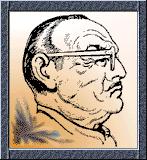
REED
CRANDALL
Crandall's work in the forties was
legendary. He was thought to be so good that, when drawing BLACKHAWK,
his editor finally asked him not to bring his work in during business hours;
it disrupted the office too much while everyone there gathered around to
admire it. He also did a lot of good work for EC in the early fifties,
primarily in their crime and SF comics.
It is rumoured that he had a bad drinking
problem that gradually erased his talent and when he bottomed out, he was
out of art altogether, working as a low paid security guard.
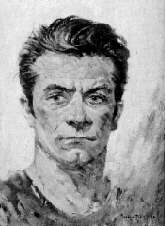

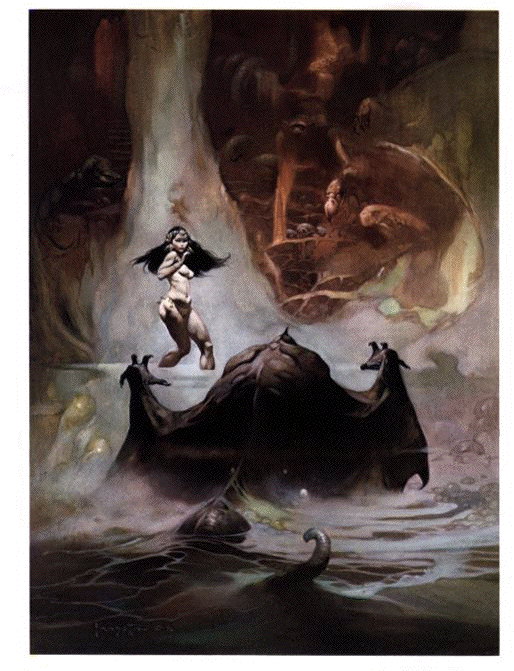
Frank Frazetta was born in Brooklyn,
New York in 1928. As early as age three he was drawing
& at eight he is reported to have been selling his work! He later went
to the Brooklyn Academy of Fine Arts.
In 1944, at the tender age of 16, his first
professional comic work appeared in Tally Ho comics, under his mentor John
Giunta. This job would lead to others & for several years he illustrated
funny animals for text stories in Coo Coo & Happy comics.
He illustrated eight "Shining Knight" stories
at DC which are highly acclaimed & also did stories for "Heroic Comics",
including a one page anti drug story which was used repeatedly
for several years.
During this time he met & befriended
Al Williamson & Roy Krenkel, two of comics' greatest talents. Each
was inspired & influenced by the other, but Al & Frank were taught
much by Roy & would later profess a great profit from his genius.
Frank worked for numerous companies including
Standard, Lev Gleason, & at Toby with Al
Williamson, and later at M.E. where he drew "White Indian" & his own
creation "Thun'da" .
Thun'da, actually a derivation of Edgar Rice
Burrough's "Tarzan" was a great achievement by any standards & Frank's
talent glowed like a supernova with this effort.
During this time he also worked for Bill
Gaines at EC Comics, and it is here that he did a number of classic stories
& covers, almost entirely in collaboration with Williamson & Krenkel.
One effort entitled "50 Girls 50" is hailed as one of the greatest stories
of all time, and another story, "Squeeze
Play" is a fabulous "Shock Suspenstory".
He contributed to the Buck Rogers mythos
by illustrating 7 covers for the Famous Funnies comic in the early fifties.
Among these seven covers are some of the most respected comic book covers
ever created. Kinetic, visceral works; these pieces jump off the books
& drill into your gut with their emotional & angry action scenes.
In 1952, Frank created his famous comic strip
"Johnny Comet," later "Ace McCoy". Lasting
for one & one half years, it was a finely drawn & brilliantly conceived
strip about a race car driver; his girl, the gorgeous Jean & his friends,
Mom & Pop Bottle. Unfortunately
the scripting by Peter DePaolo was not on a par with the art & after
an initial period of success, the strip was dropped in 1953.
Also in 1952 he went to work for Al Capp
assisting on the "Lil Abner" strip. Staying with Capp until about 1960
or so, Frank quit after Capp informed him that his salary would be cut
-after Frank had re-located to be closer to Capp's studio!
After leaving Abner he toiled for paperback
publishers doing interior illustrations (these books are highly sought
after & command high prices), and then wound up at Warren Publications
where a number of the EC artists had gathered to work on Creepy, Eerie,
Blazing Combat & Vampirella.
Frank's assignments where mostly cover paintings
&
these works are some of the most memorable
pieces of the baby boomer generation.
"Egyption Princess" (Eerie #23), "Sorcerer"
(Eerie #2), "Wolfman" (Creepy #5), "Sea Monster"
(Eerie #3) and scores of others, each is a masterpiece. While at Warren
he also drew a "Creepy's Loathsome Lore" page & another famous story
(possibly his best comic story ever) "Werewolf", the story of a crazed
"wolf-hunter" who is himself the hunted. These five pages are a momentous
achievement for the comic medium.
He was commissioned by Canaveral Press &
Doubleday Books to do illustrations for E.R.
Burroughs stories which naturally included the Tarzan & Mars series'
and he also did a number of ERB covers & interiors for the entire spectrum
of Burroughs stories for Ace Books. Some are great, others are less so.
He admittedly did three covers in one weekend to meet a deadline after
putting the assignment aside for almost three months. Two of these are
rather dull Frazetta compositions, but one of them - "Tarzan & the
Jewels of Opar" is an outstanding work of art.
A very prolific artist, Frank has been one
of the most influential & therefore one of the most important artists
of the twentieth century, Frank is certain to have carved his niche in
the history of American Art.
As a postcript, Frank this year has had two
debilitating strokes, which have severely incapacitated
him. Our wishes are with Frank for his return to good health.
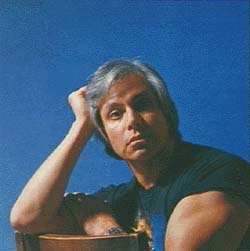
BORIS VALLEJO
Vallejo was born in Lima. His father
was a wealthy lawyer. He became interested in the arts at an early
age and studied violin for seven years. He later took an introductory course
for medical school - the anatomy studies would serve him well in his future
career as an artist. He then enrolled in applied graphics at the National
School of Fine Arts, Peru. He turned down an offer to study in Florence
but refused to go to Europe -- instead he went to New York where
he struggled to make a living and to learn English.
Six months went by, and he had already been
working at the New York Headquarters of the
company, where he met his wife, Doris. It took him two years to turn his
back to the office and become a free-lancing graphic artist. He struggled
for eight years learning the hard game played by publishers and the press.
It taught him a lot, and he learned how to vary styles rapidly, meet overnight
deadlines and to work quickly. It was the publisher Marvel Comics who took
notice of his placards and greeting cards first. A year later he was working
for the even more famous Ballantine Books. Gradually he was being recognized
in the industry for his remarkable work in SF/Fantasy and ERB covers. Today
he is the uncrowned king of this genre.
For more info
on the above artists, check out the many links featured in our
ERB
ARTIST ENCYCLOPEDIA
The ERB Illustrated Bibliography:
www.ERBzine.com/chaser
Every Burroughs Title with Publishing
History, Cover and Interior Art, Reviews, Trivia, Links, etc.
The
Fantastic Worlds of Edgar Rice Burroughs

Tarzan.com
|

ERBzine.com
|

DantonBurroughs.com
|

Tarzan.org
|

BurroughsBibliophiles.com
|

JohnColemanBurroughs.com
|

Tarzan.com/tarzine
|

JohnCarterOfMars.ca
|

ERBzine.com/edgarriceburroughs
|

Weekly Webzine
|

Weekly Webzine
|

Pellucidar.org
|

John Carter Film News
|

ERB, Inc. Corporate Site
|

ERB Centennial
|

tarzana.ca
|





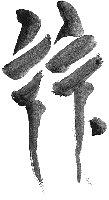
BILL
HILLMAN
Visit
our thousands of other sites at:
BILL
and SUE-ON HILLMAN ECLECTIC STUDIO
ERB
Text, ERB Images and Tarzan® are ©Edgar Rice Burroughs, Inc.-
All Rights Reserved.
All
Original Work ©1996-2014 by Bill Hillman and/or Contributing Authors/Owners
No
part of this web site may be reproduced without permission from the respective
owners.

![]()
![]()




























